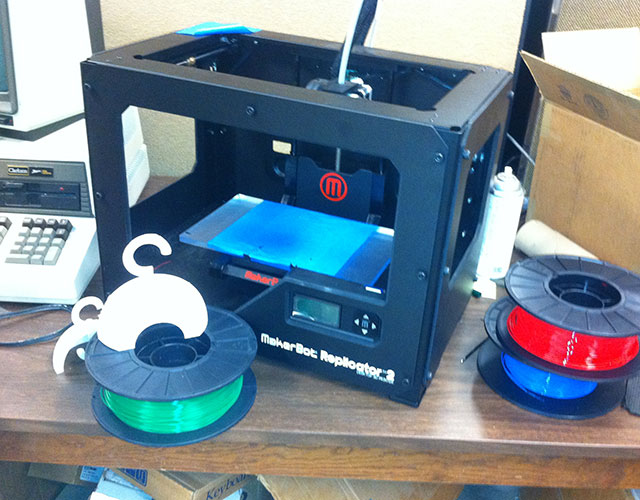Clarkson visit: what the heck is a 3-D printer?

The 3-D printer in Clarkson’s engineering lab. The spools hold the plastic-like coil that is fed into and melted by the “printer” before being squirted onto the turquoise building surface. The rounded white hanger-like objects were produced by this printer. (Historic note: the printer is quite new, acquired in the last year. The computer controlling it is a Z-100, the first computer purchased by Clarkson for its students, back in the ’80s, and later donated in large numbers to area non-profits, including NCPR, when the Z-100 was replaced by more modern models. The Z-100 was the first computer I ever used.) Photo: Ellen Rocco
Every time I hear some report about 3-D printers my brain gets snagged on the concept. What does that mean? How can you “print” three dimensions? My 20th century DNA just can’t compute “3-D printer.”
So there I was earlier today on a visit to Clarkson’s engineering building, the Center for Advanced Materials Processing (known as CAMP), and Dr. Paul McGrath was gracious enough to show us a portion of his lab allocated for experimentation…and playing around with new ideas.
It’s a modest room. I pointed out that it looked more like the labs I remember from my college years (decades ago, back in the previous century) than like something you see in those high-tech 21st century movies with wall-size computer screens, lights flashing, processors processing, and scientists flinging around numbers and tech terms that no sub-genius human could possibly understand.

Canton College Engineering Dean Emeritus Dave Wells, Clarkson Engineering Professor Paul McGrath, Pierre Nzuah, Canton College engineering student, and Dan Galy, Clarkson graduate student in electrical engineering. Photo: Ellen Rocco
Here’s the thing: I loved McGrath’s lab. When I asked about the 3-D printer sitting just inside the entrance, he immediately launched into an explanation of how it works and what it’s used for that (even) I could understand. In the case of the Clarkson 3-D printer, students use it to produce prototypes as they work out solutions to specific problems. Prototypes are tested and once the best idea is identified it can be reproduced in quantity–probably using more traditional technology because 3-D printing is a relatively slow process.
Rather than relying on my very unscientific reporting to explain exactly how 3-D printers work (Dr. McGrath did a great job but I don’t think I can accurately reproduce his mini-overview), do check out the description at more reliable sites. But Dr. McGrath helped me picture the process by comparing it to the old jet printers that squirted ink onto paper. Coils of plastic or an organic plastic-like substance are fed into the printer, melted, and then squirted onto the “building” surface. The computer program directs the placement of the plastic material, creating the architecture of the object.
Oh boy. Let me rest my brain for a minute.
We were on campus for Canton College engineering student Pierre to talk with faculty about applying for Clarkson’s graduate program in engineering. Dr. McGrath and Dr. Tom Ortmeyer were kind enough to show us some of the labs where graduate research and exploration takes place…including on 3-D printers.







